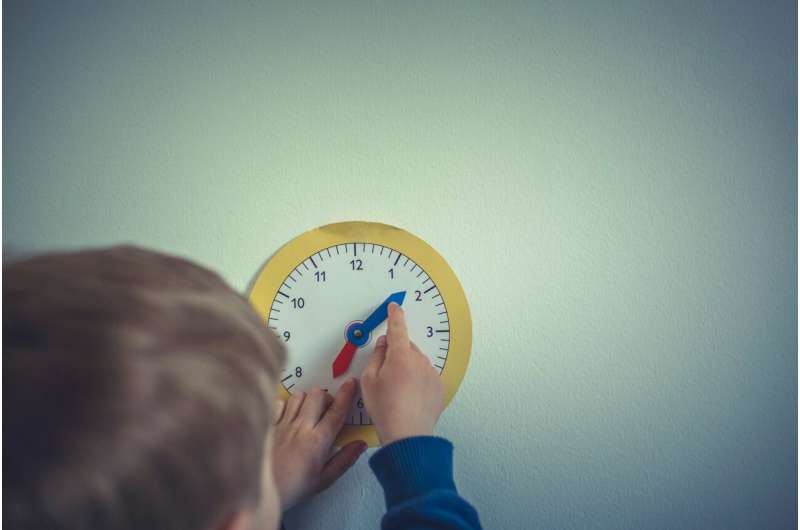This article has been reviewed according to Science X's editorial process and policies. Editors have highlighted the following attributes while ensuring the content's credibility:
fact-checked
peer-reviewed publication
trusted source
proofread
Pioneering trial offers hope for late treatment of 'lazy eye'

In children with amblyopia or "lazy eye," one eye is weaker than the other for any of a number of reasons. It may not focus as well, it may be misaligned due to strabismus, or its vision may be obstructed by a cataract or a droopy eyelid. As a result, the brain starts to favor input from the stronger eye, causing the weaker eye to lose vision.
If amblyopia is caught early enough, putting a patch over the dominant eye teaches the brain to pay attention to the weaker eye, strengthening its vision. Unfortunately, this strategy works best until about age 5 or 6. After that, the "critical period" when the brain can rewire its visual circuits begins to close, and vision loss is hard to reverse.
But it turns out certain drugs can reopen this critical period. In 2010, neuroscientist Takao Hensch, Ph.D., in the F.M. Kirby Neurobiology Center at Boston Children's Hospital, reported in the journal Science that drugs like donepezil (Aricept), a medication used for Alzheimer's disease, reversed amblyopia in a mouse model well after the visual critical period ended.
That inspired a small open-label clinical trial of donepezil at Boston Children's that is raising hope for restoring at least some lost vision in older children—and even adults—with amblyopia. While improvements in vision were modest and not universal, they were stable and could pave the way to larger, placebo-controlled trials, potentially trying different drugs and concurrent visual stimulation.
"This study was a bench-to-bedside proof of concept that brain plasticity can be rekindled," says Hensch. The trial results were published in Scientific Reports. "We hope it will inspire a larger-scale, placebo-controlled trial."
Reopening critical periods with donepezil
David Hunter, MD, Ph.D., chief of ophthalmology at Boston Children's, learned of Hensch's findings on critical periods over a decade ago and was intrigued. "Takao came to meet with me, saying, 'I have these results in the lab and want to bring them to humans,'" he recounts. "It's not often that you have that opportunity."
Because donepezil, which boosts levels of acetylcholine, was already being prescribed to enhance cognition, Hunter figured it wouldn't be difficult to start a clinical trial. He enlisted ophthalmologist Carolyn Wu, MD, to design and lead it, with the support of Boston Children's Translational Research Program.
"We were able to go straight from mice to humans without having to go through years—if not decades—of preparation," Hunter says.
A decade-long effort
Even so, the process took longer than Wu and Hunter expected. They still had to get FDA permission to use donepezil for a new indication and then had to work with a pharmacy to make custom pills with half the donepezil dose used in Alzheimer's.
Recruiting enough older participants also took time since most patients over 12 no longer make clinic visits for amblyopia. "Eligible patients were very interested, and compliance was exceptional, which is important in clinical research," Wu reports.
They ultimately enrolled 16 participants averaging 16 years of age, ranging from nine to 37. All had been treated with eye patching in the past and had stopped treatment due to no further improvement in vision.
Before receiving donepezil, children under 18 patched their weak eye for four weeks, at least two hours daily. (Adults were spared this requirement to encourage them to enroll.) After this run-in period, the children took 2.5 mg of donepezil daily while continuing to patch, while adults took 5 mg. If, at four weeks, vision hadn't improved by at least one line (or five letters) on the eye chart, the dose was increased. Doses were capped at 7.5mg for children and 10mg for adults.
A second chance for amblyopia?
After 12 weeks of treatment, participants could read, on average, 1.2 more lines in an eye chart than when they started. While some did not respond, four of the 16 had improvements of two lines or greater. The visual improvements remained ten weeks after cessation of donepezil, in both children and adults.
"The good news is that there were gains in visual acuity for some patients, none had significant side effects, and the improvements were maintained even after stopping treatment," says Wu.
Hunter and Wu are exploring different options for conducting a larger trial. One possibility is working with other large study centers across the country that treat amblyopia.
A larger-scale trial could possibly investigate other doses or formulations of donepezil, other drugs that reopen visual plasticity, or a combination of drug treatment and interventions like video games that also boost acetylcholine levels. The hope would be to attain greater, more clinically meaningful improvements—say, four to five lines on the eye chart.
"This is a base hit, not a home run," says Hunter, "but we're excited that we've made progress."
More information: Carolyn Wu et al, Durable recovery from amblyopia with donepezil, Scientific Reports (2023). DOI: 10.1038/s41598-023-34891-5

















